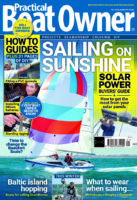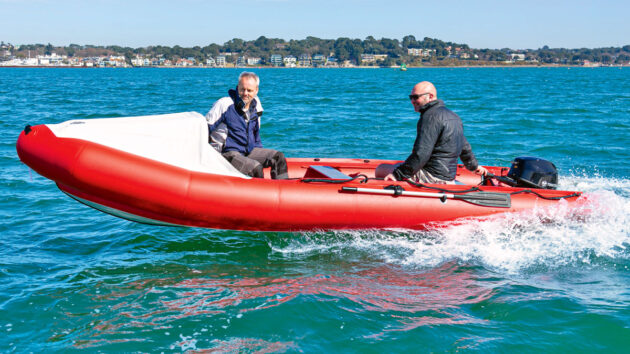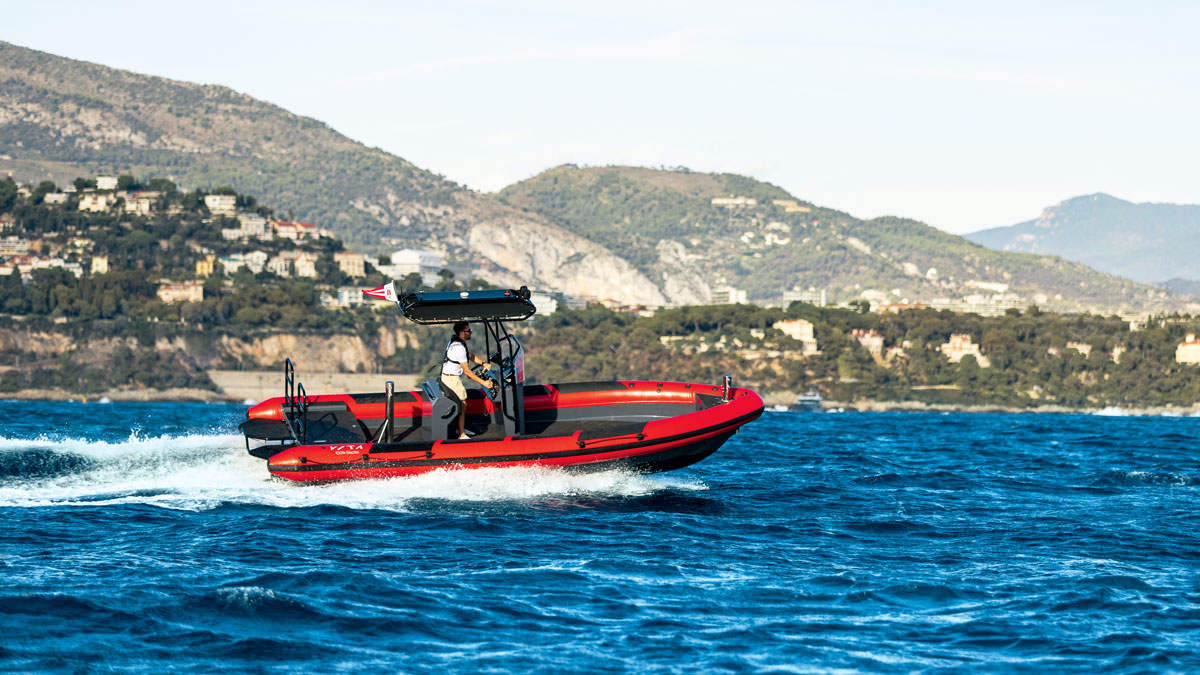What’s the point of the ‘long and thin’ as opposed to the normal ‘short and fat’ with a small inflatable? David Harding tests the SpearFish 520 to find out
SpearFish 520: fast, efficient inflatable
With boats, as with most things, form follows function: a boat’s shape reflects what it’s designed to do.
In many cases, that means you can get a pretty good idea of a boat’s likely performance and handling qualities from a cursory glance, though, of course, there may be hidden secrets below the waterline.
Sailing yachts with narrow hulls are often more easily driven, smoother to sail, better balanced, more tolerant, more predictable and better able to handle extreme conditions than wide-bodied alternatives.
Much of the time, they are also faster. Their principal drawbacks are that they can be wetter to sail – more prone to going through the waves than over them – and less roomy below decks.
In these days of pressure to maximise volume for any given length, it’s sad that the long and slim (and often elegant) has become something of an indulgence, whether you own a classic yacht or one of the small number of current designs in a similar vein.
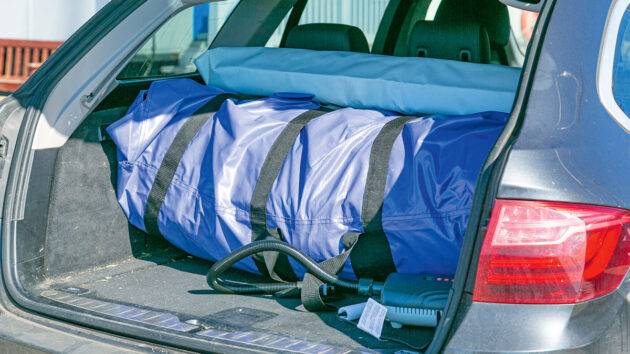
Boat in the boot: the SpearFish 520 rolls up into a bag just over 1m (3ft 3in) long. Credit: David Harding
It’s much the same story with motorboats as with sail.
A more comfortable motion into a seaway and the need for less power are among the plus-points of a narrower hull, at the expense of greater tendency to roll in a beam sea and, inevitably, less space.
So, where does that leave very small boats, including ones that you can deflate and put in the boot of your car?
Well, in broad terms – so to speak – the same applies. Have you ever seen a wide kayak or canoe? They’re narrow for a reason, and sea kayaks are long for a reason.
Tenders and small, multipurpose inflatables have always tended to be on the short and squat side, again to maximise carrying capacity for any given length.
If you’re going to carry an inflatable fully inflated on deck, across the transom or, perhaps, in davits, length does matter – not that that necessarily means buying the shortest tender that will carry what you need.
As Ian Thomson of Nestaway Boats says of his own-designed SpearFish 310, “If you think of the 310 (at 3.1m long) as having about the same capacity as a typical 2.5 to 2.7m dinghy, but in a more efficient shape, that’s about right.”
SpearFish 520:Aiming for efficiency
When Ian talks about ‘a more efficient shape’, he means longer and narrower. That makes it more easily driven by a smaller, lighter outboard, easier to row and also drier, because the finer, higher bow parts waves that tend to splash over the top of a ‘square nose’.
The SpearFish 310 was introduced as a smaller alternative to the original 450, which is a useful all-round size but too long as a tender for many cruising yachts.
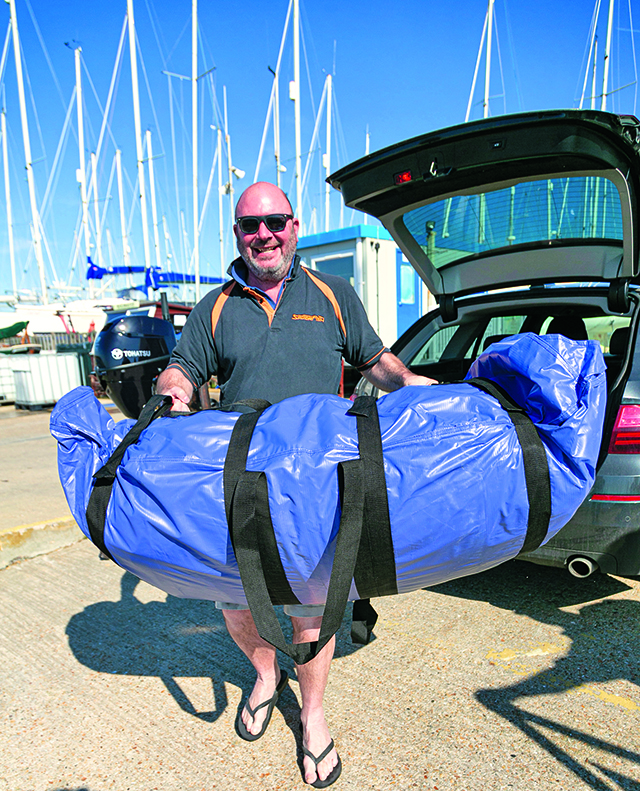
The SpearFish 520 weighs 40kg (88lb), so it’s easy to carry a few yards to the slipway. Credit: David Harding
The idea with the SpearFish range is to offer fully-inflatable dinghies that are power-efficient, dry and also more comfortable than square, flat-bottomed alternatives thanks to inflatable floors that create a V section below the waterline.
A bow canopy – also inflatable to hold its shape – is another feature, creating a dry area forward for stowing kit.
After the success of the 450 and then the 310, Ian’s next move was to create a larger model.
The 450 will accommodate three adults, or two adults and two children, and plane two-up at around 15 knots with a 6hp outboard (whereas a typical inflatable with similar carrying capacity would need 10hp).
For a longer version to achieve the same capacity as, say, a conventional 4.2m inflatable, it would need to be about 5.2m (that’s 17ft in English, though it has long been the convention for RIBs and inflatables to be named according to their length in metres).
As for the precise meaning of ‘narrow’ in this context, well, the SpearFish 450 (14ft 9in) has a beam of 1.22m (4ft), whereas the 520’s beam is 1.5m (4ft 11in).
Given that the tubes on the 520 are 42cm (16.5in) in diameter, you need a fair amount of extra length to regain the space you lose by having a beam that’s about 30% less than the norm.
But you know these boats are narrow, and that’s part of their appeal if you want the benefits.
I was particularly interested in the Spearfish 520 as a comparison with the 4.2m RIB that I often use for inshore photography.
As it happened, Ian was bringing the SpearFish 520 to Poole for our test – portability being one of its features – and I was going to need a boat from which to take the photos.
So, with the RIB being based in Poole, a comparison lined itself up.
Portability plus with the SpearFish 520
Few 17ft boats can be packed into the boot of a car, but the SpearFish 520 rolls up into a bag 110 x 60 x 40cm (3ft 7in x 2ft x 1ft 4in) that weighs 40kg (88lb).
While it’s always possible to make an inflatable lighter and more compact by using thinner or cheaper fabric, Ian hasn’t skimped with the SpearFish range, choosing German-made Valmex (essentially PVC with a polyester top layer for resistance to abrasion and UV).
Hypalon is still widely considered the ultimate for inflatable boats – if you don’t mind the price.
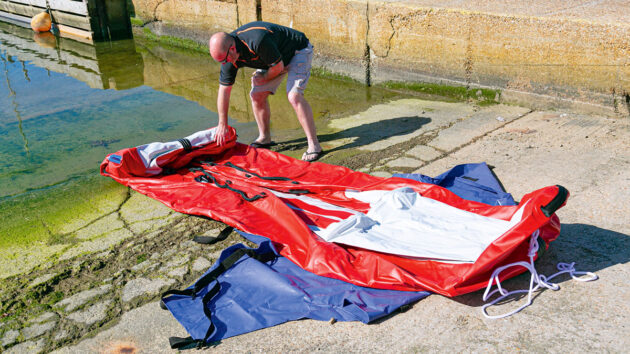
Unrolling it with the stern in the water can help if the tide’s ebbing. Credit: David Harding
Given that the SpearFish 520 sells for around £2,000, the compromise seems sensible, especially as SpearFish RIBs are made in a factory that also manufactures for well-known brands including Williams (jet tenders) and Zodiac.
Although it might sound like an appealing idea, boating from a car boot is only going to make sense for most people if it’s quick and easy to get afloat, so we noted the time at the start and finish when we inflated the boat.
Ian had already told me that, with a little practice, you can do it in 20 minutes.
If you’re on a concrete slipway, as we were, your first decision is how close to the water you’re going to start, according to whether the tide is ebbing or flooding.
We were near the start of a gentle ebb, so we unrolled the boat with the stern in the water (having inserted the transom bung) and then put the electric pump to work.
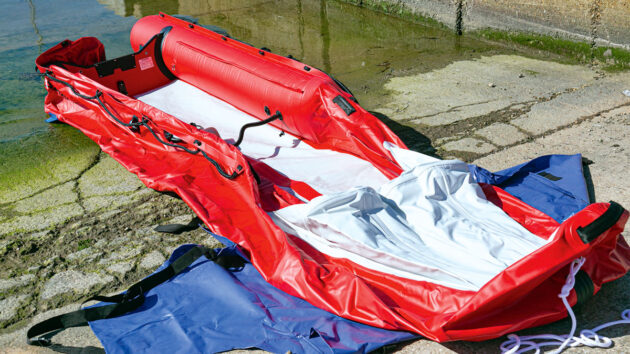
It’s easiest to use an electric pump to inflate the hull’s four primary air chambers. Credit: David Harding
Manual inflation is an option if you’re feeling fit and not in a hurry.
Ian favours the Spinera 12V two-stage pump, which acts as a compressor to push in a lot of air at low pressure before switching to piston mode and cutting out when the pre-set pressure is reached.
The hull has four chambers, and then there’s the floor incorporating the Veed keel – made from dropstitch fabric for maximum rigidity – and the bow canopy.
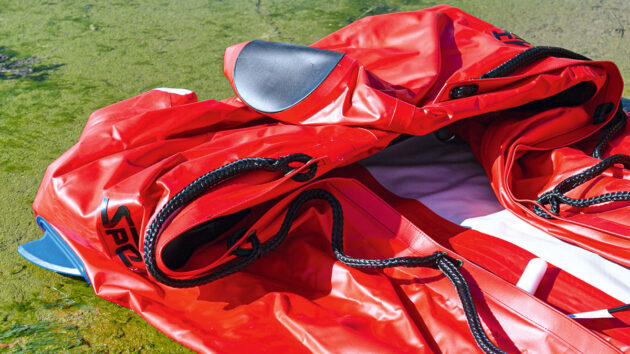
Mini fins aft, on the underside of the tubes, provide protection and help directional stability under oars. Credit: David Harding
Unless you have things to do while waiting for each section to inflate, you could speed things up by investing another £80 or so in a second pump.
They’re not exactly quiet, but certainly efficient, and should give you several inflations with a fully-charged battery.
Plug them into the car’s cigarette lighter if they run out of puff. One tip from Ian is to add a little extra pressure to the keel if you’re launching into cold water.
The water in Poole harbour and bay in March was probably around 8°C, so we could have done with a few more PSI still.
Inflating the SpearFish 520
Once inflation was complete, the three aluminium thwarts were slid into position and the oars fitted, we noted the time: we had taken exactly 20 minutes, and hadn’t rushed.
All that remained was to fit the outboard engine. But what size outboard should it be? That’s an important question.
If you want more than displacement speeds, it is a choice of 6hp or 10hp. You should plane two-up with 6hp, though each of those six horses might be working pretty hard.
The extra grunt from 10hp will offer greater speed, make life more relaxing and allow planing with three or more adults.
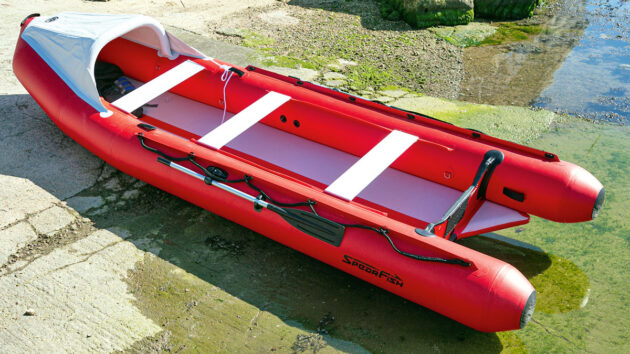
The SpearFish 520 was inflated and ready to launch after 20 minutes. Credit: David Harding
We tested the SpearFish 520 with Tohatsu’s new MFS 9.9hp 4-stroke. This is one of the first outboards of its size to feature electronic fuel injection (EFI) as opposed to a carburettor.
According to Tohatsu, at 38.5kg (85lb), it’s also the lightest outboard in its class by some margin.
Carburettors on older engines of this size come with their own potential problems, commonly related to old or dirty fuel.
Fuel injection, seen for many years on larger outboards, is generally associated with greater reliability and efficiency.
It has, however, traditionally needed a battery, whereas Tohatsu’s MFS 9.9 is battery-less.
Compared with the brand’s previous 9.9hp engine, Tohatsu claims the MFS uses up to 35% less fuel and provides 20% more torque.
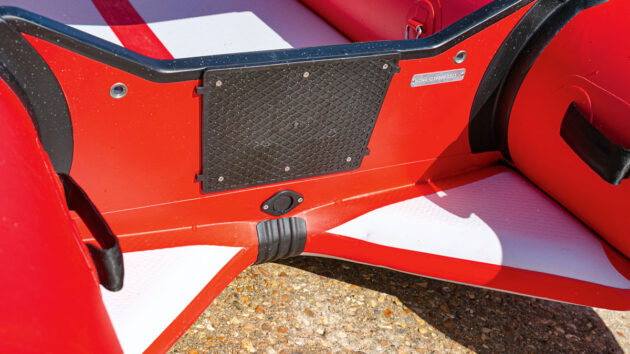
The integral inflatable floor extends abaft the transom, which incorporates reinforced holes for security strops. Credit: David Harding
Refinements have been made to the intake manifold, fuel rail and fuel injector, crankshaft, fuel pump and fuel filter, among other areas.
So that’s the background and the theory – now, what about the practice?
The first thing to say is that, while 38.5kg/85lb might be light for this sort of engine, it’s still a fair weight to heave around.
If that presents a challenge, you might be better off with a 6hp. In terms of operation, our MFS 9.9 (short-shaft, manual start) was hard to fault.
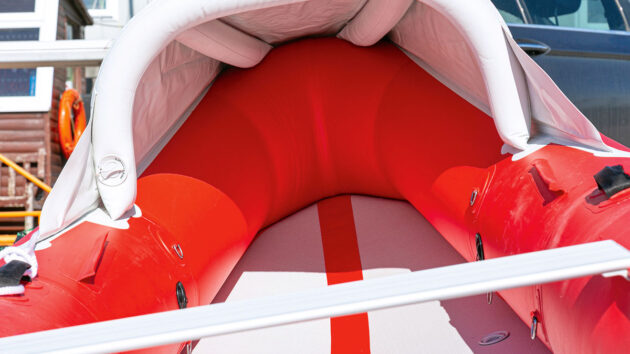
An integral inflatable canopy provides a dry stowage area in the bow, where eyelets allow gear to be lashed securely. Credit: David Harding
It started on the second pull from cold and the first pull thereafter. It idled happily and delivered power smoothly as the throttle was opened, all the while remaining quiet enough – even at full chat – for a normal conversation to take place between two people.
It was in marked contrast to the ex-RNLI 25hp Mercury two-stroke on the RIB, which belches out blue smoke and sounds like a bag of nails being emptied into an oil drum.
But it works, and always has done, proving that the inherent simplicity of the 2-stroke still has much to be said for it.
Interestingly, although branded Mercury it was also made by Tohatsu, which makes many of the smaller engines for other brands.
Single or double?
I tried the SpearFish 520 both on my own and with Ian on board.
For single-handed use, a tiller extension is essential so you can get your weight forward; otherwise, the bow would blow and bounce all over the place.
With another person or two to keep the bow down, you won’t need the tiller extension.
As you would expect from such a long, light, easily-driven boat, there was practically no transition between displacement and planing speeds.
It just accelerated, left the transom turbulence behind, and that was that: we were planing.
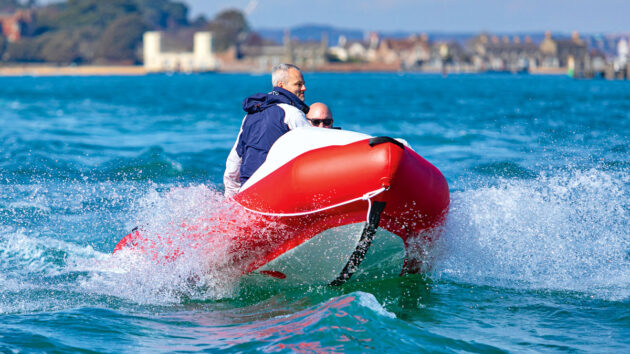
A shallow V section created by the inflatable floor gives the SpearFish a softer ride in waves than flat-bottomed inflatables. Credit: David Harding
Wake at any speed was minimal, and certainly a good deal less than that of the much heavier RIB.
In flat water, the SpearFish 520 handled very nicely indeed, peaking at around 17 knots one-up and losing only about three knots when two-up.
That’s likely to be fast enough for most situations.
As we headed out of the harbour and into the slight chop kicked up by a moderate easterly in Poole Bay, we almost inevitably bounced around more than the RIB, despite being 1m (3ft 4in) longer.
I say ‘inevitably’ because the SpearFish 520 is a fraction of the weight and with a much flatter hull.
The V-section created by the inflatable keel is nowhere near as deep a V as can be achieved with the solid hull of a RIB, and that makes a difference when the sea kicks up.
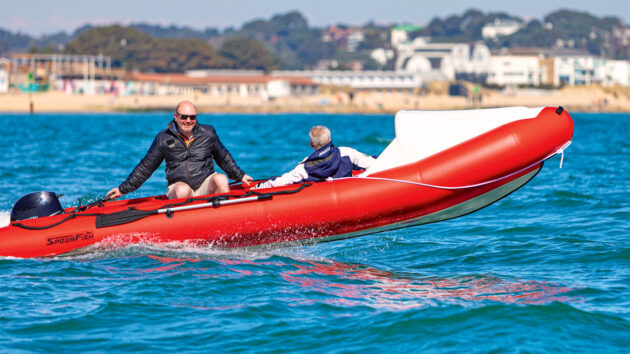
The SpearFish 520 is not designed as a seagoing boat, but the 520 comfortably handled the small chop in Poole Bay. Credit: David Harding
You might argue that there’s limited value in comparing a car-boot-able inflatable weighing less than 100lb with a RIB that has to be towed on a trailer and weighs at least three times as much.
That would be a fair point. It made an interesting comparison nonetheless.
Despite being in a bouncier boat with an inflatable floor rather than a solid deck under foot, I was still able to stand (my preference) and steer with the tiller extension.
What you do have to bear in mind with an extension is that it describes a pretty wide arc when you’re turning tightly, and that places the end of the extension some way outboard of such a narrow boat.
You just need to position yourself accordingly.
Although we bounced over a few waves, two points were of note. One is that the boat felt surprisingly rigid, and the other is that very little water splashed aboard.
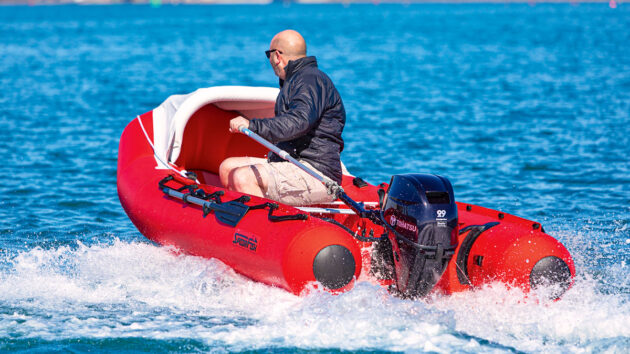
For single-handed use, a tiller extension keeps your weight further forward. Credit: David Harding
The pint or so that ended up in the middle of the Veed floor could easily be sponged or bailed out.
If you prefer to sit rather than stand, you have the three aluminium thwarts as well as the tubes.
The fuel tank is probably best out of the way right aft, leaving the rest of the floor for kit or people’s feet.
Ian makes the point that the floor is glued to the bottom of the tubes, maximising its rigidity and keeping it lower than the commonly used separate floors to create extra height between the floor and thwarts.
If you don’t want to inflate the arch and the two fore-and-aft tubes that support the bow canopy, you don’t have to.
The canopy will still be there; just acting as a loose cover.
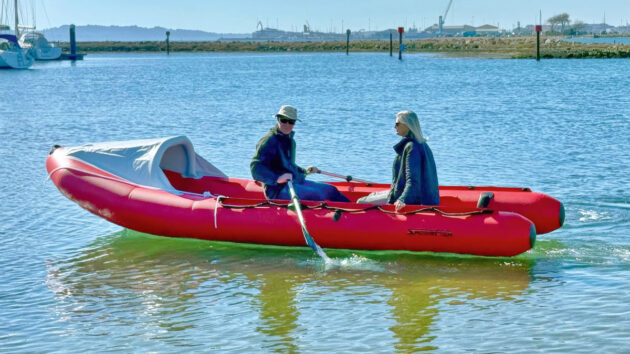
Row, row, row the boat…unlike most inflatables, the SpearFish 520 rows very nicely. Credit: David Harding
When you’ve had enough of whizzing around with the outboard engine, and fancy some gentle exercise, you can take to the oars.
Whereas a typical square-shaped, flat-bottomed inflatable is horrible to row and has no directional stability, the SpearFish 520 rows very nicely.
You can even feather the oars. It would just be nice if the oars were a little longer.
The trouble is that a greater fixed length wouldn’t stow outside the tubes in the same way, so they would have to be telescopic.
Given the amount of rowing anyone is likely to do, for most people that’s an unnecessary refinement.
Verdict on the Spearfish 520
The idea of the long, narrow inflatable isn’t new: blending a kayak and a boat has been done before.
Where the SpearFish 520 differs is, for example, in having an integral dropstitch floor and incorporating an inflatable keel within it to create the V-sections forward for a smoother ride.
A bow canopy is another good idea, as are the mini fins on the aft end of the tubes to protect the hull on the beach or slipway.
Many details have been given careful thought, such as the positioning of the air valves at the forward end of each compartment, so the air gets squeezed out as you roll the boat up from the stern.
The SpearFish 520 is a practical demonstration of why the long and thin make sense.
It won’t suit everyone but, if you’ve only experienced the short and fat, you might find it quite an eye-opener.
Vita Power Seal and Sea Dog: the new electric RIBS which can run at 6-8 knots for 10-25 hours
With a reputation for ‘plug and play’ electric propulsion, Vita Power has launched electric RIBs of its own design. Jake…
Best inflatable boat: 9 compact tenders put to the test
Inflatables are everywhere: paddleboards, canoes, kayaks, tents, kites and wings – and inflatable boat technology has long been a practical…
Duchy 27: the motor launch fit for a duke
The Duchy 27 started life as a Aquila 27 before being tweaked by Cockwells Modern and Classic Boatbuilding. David Harding…
Westons Point 27: the head-turning gentleman’s launch
A semi-bespoke gentleman’s launch in cedar strip construction, the Westons Point 27 is a real head-turner that oozes traditional craftsmanship,…
Want to read more boat reviews?
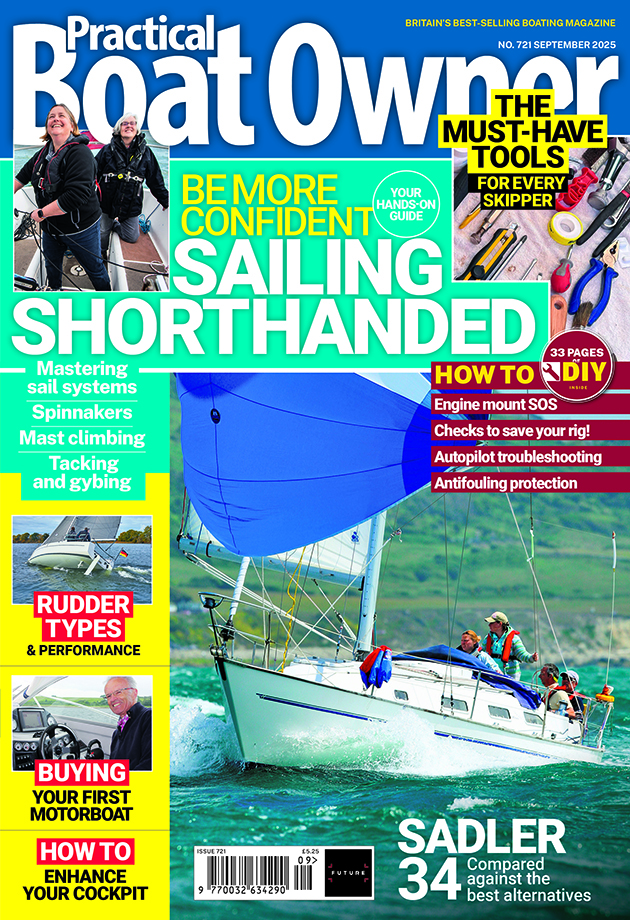
A subscription to Practical Boat Owner magazine costs around 40% less than the cover price.
Print and digital editions are available through Magazines Direct – where you can also find the latest deals.
PBO is packed with information to help you get the most from boat ownership – whether sail or power.
-
-
-
- Take your DIY skills to the next level with trusted advice on boat maintenance and repairs
- Impartial, in-depth gear reviews
- Practical cruising tips for making the most of your time afloat
-
-
Follow us on Facebook, Instagram, TikTok and Twitter

